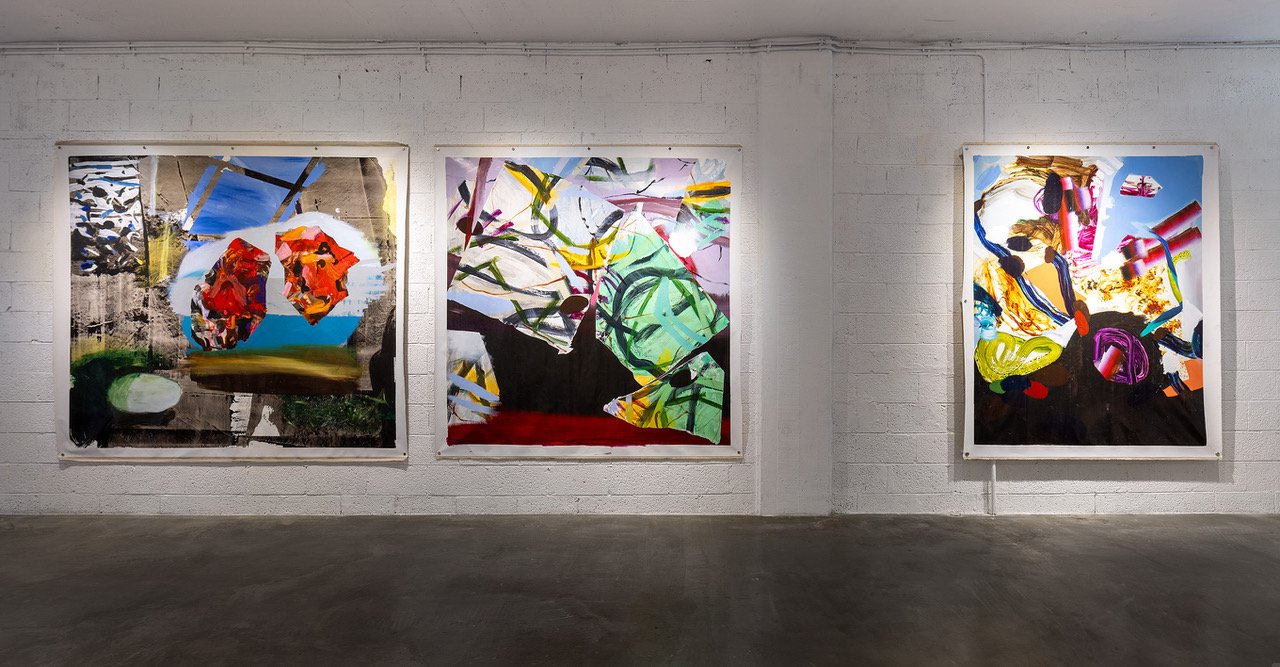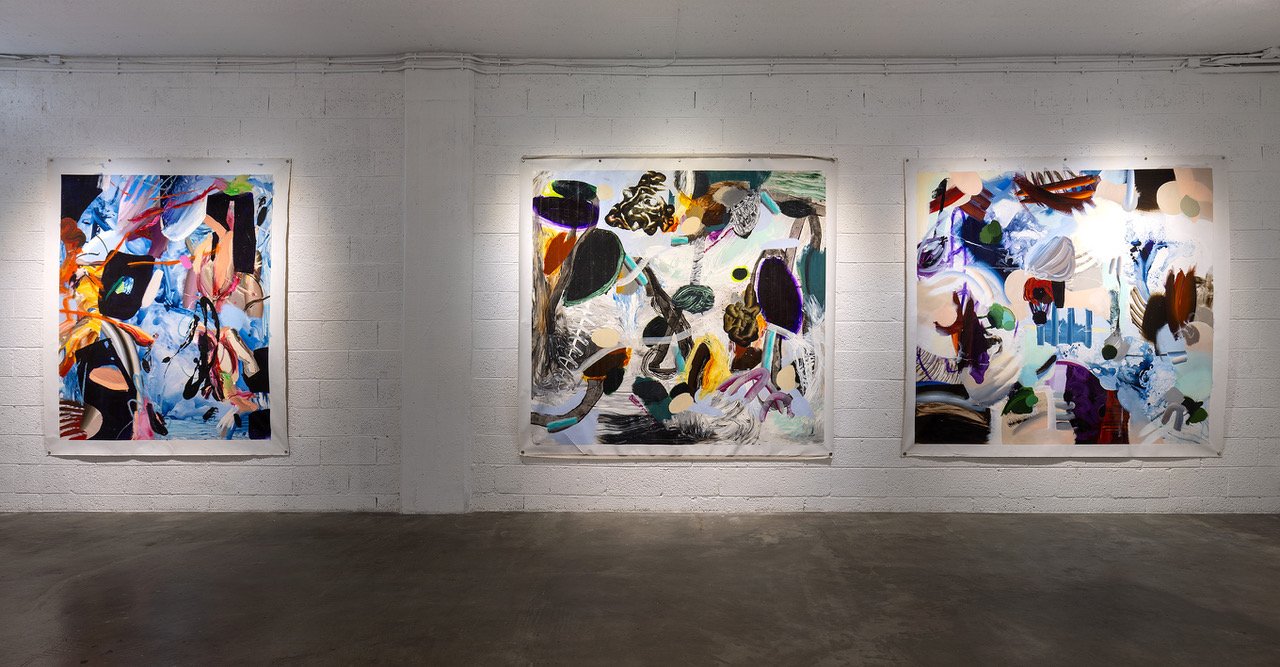The Place will summon us
2025
NULOBAZ, Cooperative Art Space, Tel Aviv Curator: Avshalom Suliman
Spectacular. Struggle
Text by: Avshalom Suliman
Welcome. Nothing has changed in the Nulobaz Gallery space, yet you may feel as though you have entered a different place—a place contained within Painting. The Place Will Call, Shony Rivnay’s new exhibition, features nine paintings from the years 2021–24, seven of which are large-scale works. This is a small selection from a much larger body of work created over the past decade. It has been six years since Rivnay last exhibited paintings on this scale, in an exhibition titled Wave Theory at the Artists' House in Tel Aviv and in Nature of Wonder at New York’s ZAZ10TS. A comparative look at his 2019 exhibitions and the current one reveals the new directions in which his work has evolved , becoming less graphic and more open to process, its constitutive processes resolved in a different manner than before.
The period between the end of the COVID-19 pandemic and the Iron Swords war has cast the past few years in the heavy hues of social isolation, crisis, and danger. With the weight of war looming in the background, the paintings appear as frozen moments of an unresolved struggle. They embody a complex system of interdependent relationships—negation and fertilization, appearance and disappearance, flourishing and destruction. All these processes coexist simultaneously within the paintings. Do the opposing forces on the surface threaten to cancel each other out, or do they, instead, nourish one another? Rivnay attests to his careful approach, painting up to the point where the physical materials of the painting almost suggest a figurative option—then stopping there, suspending the work in its openness. As a non-objective painting—lacking a figure aside from the figure of the painter standing behind it — the challenge for these works lies in their openness to interpretation, a quality that risks severing them from the time and place in which they were created. In this exhibition, Rivnay aims for a balanced point between painting as presence and painting that, even if not explicitly, reveals the conditions of its existence and surroundings.
Rivnay’s painting is formally alive and vibrant, almost in a literal sense. It derives its vitality from the numerous collisions and interactions between colors and shapes, painterly gestures, and textures which inhabit it’s surface. The scale, finish, and presentation of the works—that is, the way they are thought out as a place of engagement with the viewer—exude a sensibility that, until a few years ago, seemed to communicate something “un-local.” His sculptures and objects are created with a meticulous consideration of well-crafted surfaces, while the paintings—especially those in this exhibition—ponder display spaces which are vastly different from that of traditional galleries in Israel.
Indeed, Rivnay acknowledges that part of his motivation in the studio has been to do things differently, to distinguish himself from his surroundings, and to create in relation to an internal compass but also with an awareness of other, possible cultures. Writers such as Dr. Smadar Sheffi and curator Kathy Battista have placed Rivnay in relation to developments stemming from Abstract Expressionism and American Color Field painting. Formally, he employs principles of push-pull painting as formulated by Hans Hofmann in the 1950s, while the more open areas of his paintings evoke the later works of Arshile Gorky (compare, for example, And We Will Also Talk About This from 2023 to The Liver is the Cock’s Comb, completed by Gorky in 1944). However, such comparisons may mislead us as to what’s at stake here. A more interesting question is whether something in the paintings points to a more subtle connection with the place and time of here and now — beyond the mere fact that Rivnay is an Israeli artist – and if so, why.
The paintings in the exhibition offer a dynamic interplay of attraction and rejection with the viewer, and it seems fitting to describe them as sites of courtship: this ‘forest’ of paintings unfolds before us as a landscape of visual delight, yet the ‘trees of the forest’ threaten to overwhelm us with their dense visual information and the multiple events unfolding between the canvases. What shapes this relationship is the balance of different types of beauty the paintings offer—soft and hard, colourful and lush, but also sparse and harsh. This balance is achieved intuitively, through the painter’s skills and experience in the studio, rather than through precisely calculated equations. On an experiential level, the invitation remains open, and this energetic tension brings us back to the question: What, after all, does Rivnay’s painting seek to awaken in us? Does it aim merely to delight the viewer, or does it, through pleasure and abundance, point to something that transcends both? What, in essence, is painted in these works, and what do we see when we look at the world through them?
There is no inherent contradiction between these two desires. One can seek honest communication with the viewer while embedding difficult messages within it, just as a great painting can depict disaster and still be breathtakingly beautiful. I propose that it is precisely this lack of resolution that is the most useful way to experience Rivnay’s painting. When viewed together in a single space, the paintings offer a continuous landscape, however devoid of a single horizon line it may be. They invite us, if you will, to decide whether the perspective and the kind of looking they evoke is akin to looking through a telescope, a microscope, or a field binocular. These paintings are indeed an inner gaze into psychological landscapes, and they can also be thought of as Petri dishes feeding on both the micro- natural (enzymes and bacteria, blood cells and viruses) and the macro-natural (glaciers collapsing into the ocean in Iceland, nebulae giving birth to stars, and so on). But alongside all these possibilities, the DNA awaiting discovery within the paintings, the painterly actions within them, bring the work back to the here and now—to the physical and mental present in which they were created.
This is one possibility—by no means the only one. I recall the series of painted wall debris Rivnay exhibited in 2013; stunning geometric patterns and flowers painted on shards of perforated drywall, like remnants of ruins from a war zone. Perhaps, similar to the shift Philip Guston made in the later part of his career when he returned to painting the violence and racism that haunted his childhood in the American South, what emerges from the paintings in The Place Will Call, beyond the sheer joy of painting itself, is the fractured face of the place itself.



